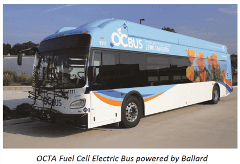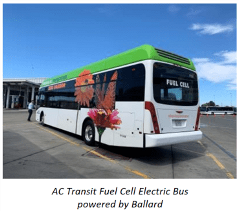Ballard Power Systems (NASDAQ: BLDP; TSX: BLDP) today confirmed the issuance of zero-emission bus rollout plans by Orange County Transportation Authority (OCTA) and Alameda-Contra Costa Transit District (AC Transit), in compliance with the California Air Resources Board (CARB) Innovative Clean Transit Regulation.
CARB adopted the Innovative Clean Transit Regulation (ICT) in December 2019 to ensure the deployment of zero-emission buses in California, where transit agencies currently operate approximately 12,000 diesel buses statewide. CARB’s ICT applies to all revenue vehicles with a gross vehicle weight rating over 14,000 lbs. A zero-emission bus has no tailpipe emissions and is either a Fuel Cell Electric Bus (FCEB) or a Battery Electric Bus (BEB).
Under Innovative Clean Transit Regulation, transit agencies must follow a phased schedule: starting in 2023, 25% of new 40-foot buses must be zero-emission; starting in 2026, 50% of new 40-foot, 60-foot buses and smaller cutaway buses must be zero-emission; starting in 2029, all new buses must be zero-emission. In addition, by 2040 100% of all bus fleets must be zero-emission. CARB also previously put rules in place to ensure electrification of all buses used by transit agencies and shuttles at California’s largest airports, by 2030. The estimated impact of the ICT will be equivalent to removing 4 million cars from California’s roads.
“Ballard modules are powering 37 of the 48 Fuel Cell Electric Buses currently operating in California, for a 77% penetration rate, though we believe this market is just now beginning to grow,” said Randy MacEwen, Ballard President and CEO. “The Innovative Clean Transit Regulation will create real momentum in zero-emission bus deployments in California. Together with the Advanced Clean Truck Regulation, these represent highly progressive policies that put California at the forefront in addressing the impacts of climate change in North America.”
Mr. MacEwen continued, “Ballard has focused on design and production of zero-emission fuel cell power solutions for Heavy- and Medium-Duty Motive applications, including buses and commercial trucks. Our fuel cell value proposition is particularly strong where application requirements include heavy payload, extended range and rapid refueling. We look forward to the deployment of increasing numbers of fuel cell-powered buses and trucks in California and beyond, given a $133 billion per year estimated total addressable market for bus and truck engines globally.”
Under the Innovative Clean Transit Regulation, transit agencies with fleets of at least 100 buses were to submit a rollout plan by July 1, 2020, addressing purchases of clean buses, build-out of necessary infrastructure and training of required workforce. Smaller transit agencies must submit rollout plans by 2023.
Two of California’s largest transit agencies – Orange County Transportation Authority and Alameda-Contra Costa Transit District – are presently operating Fuel Cell Electric Buses and Battery Electric Buses in regular service, and their recently issued zero-emission bus rollout plans include important data and preliminary conclusions.Or
Orange County Transportation Authority (OCTA)
In June 2020, OCTA – which operates more than 500 buses serving a population of approximately 3 million people – unveiled its zero-emission bus rollout plan. In its plan, OCTA summarized work conducted to date, including these points:
-
Detailed route mapping indicates that many routes cannot be served by battery electric buses (BEBs) without charging buses at the ends of the route or mid-route.
-
Modelling included a 100% Fuel Cell Electric Bus fleet as well as a mixed-fleet of FCEBs and BEBs having depot and on-route charging. The 100% FCEB scenario showed a slightly lower overall cost than the mixed-fleet given current vehicle, fuel, and support infrastructure pricing, of $2.05 versus $2.07 per bus per mile over 18-years.
-
Results indicate that FCEBs offer extended range and a better match to OCTA’s current operating parameters. By comparison, the current range of BEBs may require more vehicles and drivers to meet similar service levels.
current operating parameters. By comparison, the current range of BEBs may require more vehicles and drivers to meet similar service levels.
-
General BEB operations would require cooperation from other agencies to install charging infrastructure along bus routes, making operation more complicated and potentially affecting service reliability.
-
The 100% FCEB scenario most closely approximates the current CNG bus range, CNG bus operations and current CNG “business as usual” scenario.
-
Based on results of its analysis, the OCTA rollout plan focuses on using FCEBs for fixed-route operations.
OCTA currently operates 10 New Flyer Fuel Cell Electric Buses powered by Ballard, which have logged more than 170,000 total miles. The Ballard fuel cell modules powering these buses delivered 100% availability during the most recent weekly reporting period.
OCTA’s zero-emission bus rollout plan provides insightful details from its analysis of zero-emission options that may be a valuable reference point for other transit agencies. OCTA plans to test 10 FCEBs and 10 BEBs as part of a pilot project to gain further experience with each technology.
Alameda-Contra Costa Transit District (AC Transit)
In June 2020 AC Transit – which operates more than 600 buses serving a population in excess of 1.5 million people in the Bay Area – also unveiled its zero-emission bus rollout plan. In its plan AC Transit made these points:
AC Transit will continue with small-scale deployments of FCEBs and BEBs, taking advantage of various grant and incentive programs to offset incremental costs.
-
The strengths of both technologies will be considered in order to take full advantage of each. For example, depot-charged BEBs can be used for shorter routes and blocks, on-route charged BEBs for mid-range routes with layovers at a transit center, and FCEBs for long routes or routes with requirements for higher speeds and/or heavier loads.
-
AC Transit reports that, to date, maintenance costs for its FCEBs have been approximately 68% lower than BEB maintenance costs, and total-cost-per-mile for its FCEBs has been approximately 10% lower than BEB total-cost-per-mile.
approximately 68% lower than BEB maintenance costs, and total-cost-per-mile for its FCEBs has been approximately 10% lower than BEB total-cost-per-mile.
- AC Transit currently operates 11 Fuel Cell Electric Buses powered by Ballard, which have logged more than 120,000 total miles. The Ballard fuel cell modules powering these buses delivered 100% availability during the most recent weekly reporting period.
Additional transit agencies – such as San Diego’s Metropolitan Transit System – have issued draft zero-emission bus rollout plans or are expected to issue plans in the near future.
About Ballard Power Systems
Ballard Power Systems’ (NASDAQ: BLDP; TSX: BLDP) vision is to deliver fuel cell power for a sustainable planet. Ballard zero-emission PEM fuel cells are enabling electrification of mobility, including buses, commercial trucks, trains, marine vessels, passenger cars, forklift trucks and UAVs. To learn more about Ballard, please visit www.ballard.com.
Contact: media@ballard.com